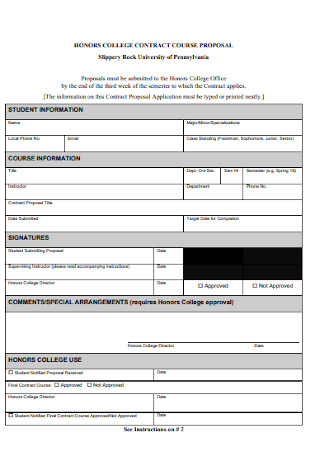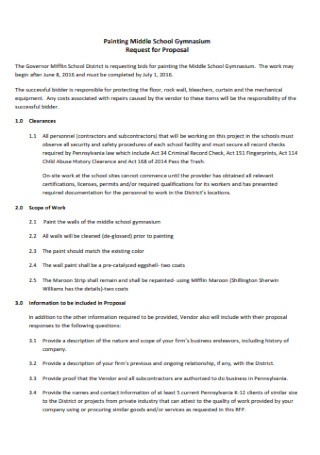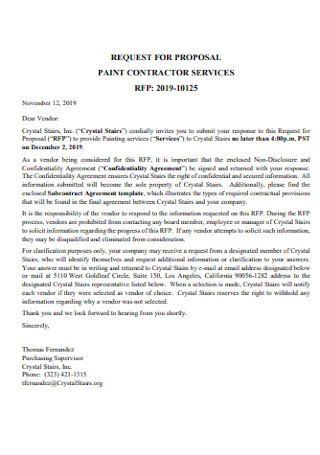29+ Sample Contract Proposals
-

Standard Form of Contract Proposal
download now -

Honors Contract Proposal Example
download now -

Program Contract Course Proposal
download now -

Proposal for Annual Maitenance Contract
download now -

College Contract Course Proposal
download now -

Contract Pricing Proposal Cover Sheet
download now -

School Painting Contract Proposal
download now -

Contract Class Instruction Proposal
download now -

Internship Proposal and Contract
download now -

Agency Contract Proposal
download now -

Dissertation Proposal Contract
download now -

Grounds Maintenance Contract Proposal
download now -

Public Works Contract Proposal
download now -

Grant and Contract Proposal
download now -

Honors Option Contract Proposal
download now -

Standard Contract Proposal
download now -

Proposal Checklist for Contracts
download now -

Request for Contract Proposal
download now -

Contract and Proposal Manager Template
download now -

Contract Proposal Form
download now -

Contract Bond Proposal
download now -

Initial Contract Proposal
download now -

Contract Proposal Cover Sheet
download now -

Professional Service Contract Proposal
download now -

Contract Proposal Meeting Sign in Sheet
download now -

Job Contract Proposal
download now -

Contract Bid Proposal
download now -

Amendment to Contract Proposal
download now -

Paint Contract Service Proposal
download now -

Landscaping Contract Proposal
download now
FREE Contract Proposal s to Download
29+ Sample Contract Proposals
Proposal vs. Contracts: What’s the Difference?
What is a Contract Proposal?
Key Elements in a Proposal
Key Elements of a Contract
FAQs
What is a Contract Proposal
How Do You Write A Contract Proposal
What is the Difference Between a Contract and a Proposal?
To understand more of the distinction between contracts and proposals, this article will detail the primary difference between the two and at the same time how a contract proposal is possible despite these differences. The article shall also define what a contract proposal is and when it is best employed. With our printable Contract Proposal templates, you can start drafting one of your own to start securing potential partnerships or projects.
Proposal vs. Contracts: What’s the Difference?
Proposals are not binding agreements. That’s the significant feature that sets both a contract and a proposal apart. A proposal merely serves as a plan or a suggestion that whoever it is presented to can take into consideration. In the business industry, a proposal can be a written document that communicates how a project, product or services can address the business’ problem or the business’ needs. Proposals are only meant to further the conversation with the goal of enticing the other party to want them to enter into a formal agreement with you. It is only the first document that you are to present to a potential client if you were to secure a project, job or business partnerships with them so its content is mainly to detail the kind of service that you can offer or the plan that you have in mind as opposed to specifying the conditions that the proposal can work under.
A contract, on the other hand, is a legally binding agreement between you and a prospective client. It defines the terms and conditions and a couple more legalities that the participating parties should be in mutual agreement and commit to complete. This means that as soon as the parties involved sign the contract, they are bound to comply with its details because otherwise, they will face repercussions such as penalty fees or worse, contract disputes that most times, are likely to be taken to court and will cost both parties more, all of which must be reflect in the contract. The details of the contract are centered on how both parties can ensure the project’s process will run and avoid confusions more than detailing what the project is about since the proposal should have already expounded more on that. To summarize the function of a contract into a single sentence, it is basically a legal agreement that commits both parties to perform and refrain from performing the specified actions in a given task.
A contract and a proposal are likely interchanged because the terms set forth in the proposal can be the same terms and conditions that the finalized contract will be composed of, especially if the client seems to be already in agreement with them. However, it is still important to not get them confused because again, a proposal is not binding which means that regardless if both parties seem to be in agreement with what the proposal outlines, they do not necessarily have the responsibility to fulfill them. A proposal allows a space for reconsideration, rejection, or approval. While there is still a good chance that you do not get your desired results when your proposals decline, there is also an equal chance that you can proceed into legalizing the agreement once modifications in the proposal’s content have been made.
What is a Contract Proposal?
A Contract Proposal is a document potent to be a legally binding agreement once both parties involved have negotiated the terms and conditions established in the proposal and finalize it. It is merely a draft that awaits a potential client’s agreement to enter into a contract once the necessary amendments are made and the framework is modified to best fit the circumstance. Once an agreement is made, the contract proposal can transition into being the contract itself where the participating parties can affix their signatures to confirm the validity of the relationship and for the agreements to take effect. An oversimplified definition of a contract proposal is that whatever is outlined in a contract and a proposal respectively can be found in one document and this document being the Contract Proposal meaning, it shall extensively detail what the project is, the situation that calls for the proposal as well as well as how the project will address the situation at hand plus specify the legal terms and conditions that shall govern the whole process that will involve the payment agreement and schedule, the whole duration of the project thus the contract’s effectivity as well as an agreement for contract termination and the overall costs incurred.
A contract proposal can be utilized by those in the business or are looking to sell their professional services. Although, to combine the two is discouraged for freelancers since the idea of being proposed to a contract can be overwhelming to a client who might just be looking for quick services that do not require the involvement of legalities. However, it does ensure that only those who are confident to come to a contract agreement abiding the terms and conditions you have established or can request to make reasonable adjustments will make contact with you.
Key Elements in a Proposal
Proposals can come in so many forms like a Grant Proposal, Research Proposals, Business Proposals, etc., and understandably, its structure can vary including the components it must include. However, there are key elements that proposals generally share and this section of the article will itemize them and provide their key information:
1. Abstract or Project Summary
This should briefly encapsulate the entirety of your proposal in no less than 150-250 words. While brief in explanation, it should be written in a way that captures the attention of whoever you are presenting your proposal to as it this section is what they will likely read and take into consideration if they are to spend their time reading the rest of your proposal. Introduce everything about your proposal, most importantly its relevance which should be able to identify a problem that your proposal will target and how your prospective client can benefit from it as well as the objectives that as much as possible are aligned with the client’s vision. To come up with objectives that are for sure to attract the client’s attention, it is best to follow the SMART Goals which in brief, wants you to create goals that are Specific, Measurable, Achievable or Attainable, Relevant or Realistic and Time-bound or Timely. Moreover, this section should already be able to describe the activities that are to be taken in order for the objectives to be met and ultimately the problem can be addressed. Because this includes only the highlights, it is encouraged to formulate this section after the whole of the proposal is made, which is why it is important to plan ahead and follow a proper schedule that can allow you to best develop your proposal.
2. Proposal Background
Th background of your proposal describes what the project is about. This entails what the problem the proposal desires to address and the corresponding goals and objectives that need to be met all the while producing the concrete outcomes for problem resolution. This section should also detail the methods, an activity plan and a definite work plan in order to realize these aims as well as how the project will be sustained despite its initial completion. As much as possible, write the background as persuasively as possible as you are still proposing an idea that you want your client to entertain. Write your proposal background with intent to sell it.
3. Budget
The budget section for your proposal shall not only indicate a reasonable estimate or the whole cost needed of the proposal but also justify why the amount is so. Provide a detailed breakdown of the needed budget costs so as the prospective client is aware of how much they should invest in the proposal and where their money will go should they choose to forge a partnership with you.
4. Timeline
This part of the proposal shall simply outline the duration of when the project can be completed. While relatively simple, this section should still be detailed and is proportionate to the budget, materials and resources that are available.
Key Elements of a Contract
The Judicial Education Center of The University of New Mexico posits that a contract is composed of four elements which a presiding judge will firstly question in order to determine if a contract between the parties involved did exist in the first place. This justification is mostly done when a party claims the other party has breached the contract therefore the need for a contract to be presented. This is why it is advisable for an agreement to be written as opposed to it being verbal because should conflicts arise, a verbal agreement will be difficult to prove in court. However, regardless of whether the contract is written or verbal in form, it must have the four essential elements to prove the validity of the contract. The four elements are as follows:
1. Offer
A contract must display the pledge of both parties that they are willing to enter into a contract that commits them to perform the actions tasked and refrain from performing the specified prohibited actions for the whole duration that the contract is effective. To state the offer is how a contract usually begins. Moreover, an offer can be the pledge to issue a payment for the party rendering their professional services and labor.
2. Consideration
Consideration can be anything of value which may take the form of money, a promise of service, or objects that have monetary value. These will be paid in exchange for the rendered service and is essentially what entices the parties to enter into a contract and is what the counteract is founded upon. While not exclusive to money, most considerations come in the form of such, however, the point should be that it is recognized to be the contract’s consideration. The presence of consideration is what distinguishes a contract from a gift since the latter is the voluntary transfer of property from one person to another without consideration or the promise of receiving something in return. A consideration may be:
3. Acceptance
Acceptance is the unconditional acceptance of the terms and conditions specified in the contract. When the party that is offered the contract confirms their acceptance, they are confirming that they have understood and agreed to comply with them and this effectively makes the agreement a legally binding one. Take note that the acceptance follows the mirror image rule or the absolute acceptance rule wherein, the terms of the offer must be accepted exactly as it is. Otherwise, negotiations can continue, counteroffers can be made and until the terms are accepted as is, then the mirror image rule has been applied. An acceptance comes in three types: Conditional, Express or Implied.
4. Mutuality
This refers to the unequivocal understanding or agreement between participating parties that makes a contract legally enforceable. This simply proves that both parties recognize the terms and conditions of the contract and have willingly bound themselves to perform the obligations outlined in it all the while adhering to the guidelines set forth.
FAQs
What is a Contract Proposal
A Contract Proposal can essentially be a legally binding agreement between participating parties. This document is a hybrid of a Contract and Proposal that explains in detail what the proposal is about all the while outlining legal terms and conditions through which the proposal can function on. However, it still offers modifications and even total rejection thus why it’s not as final as one might think.
How Do You Write A Contract Proposal
One can write a contract proposal following the key elements of a contract and a proposal respectively. This can include:
- Abstract or Project Summary
- Proposal Background
- Budget
- Timeline
- Offer
- Consideration
- Acceptance
- Mutuality
What is the Difference Between a Contract and a Proposal?
A significant difference between a Proposal and a Contract is the former is not a legally binding agreement but rather initiates to further the conversation with equal chances of rejection or approval. A Contract on the other hand lays out the legal terms and conditions that will bind the parties involved once they choose to affix their signature meaning they are legally bound to perform the tasks while adhering to the terms and conditions that are established and mutually agreed upon by the parties.
